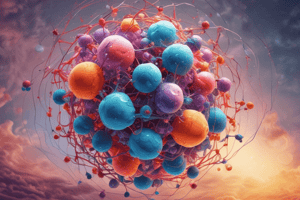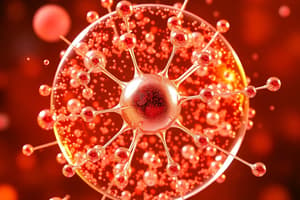Podcast
Questions and Answers
What are the characteristics that particles of matter exhibit?
What are the characteristics that particles of matter exhibit?
Particles of matter have mass, occupy space, have kinetic energy, are in constant motion, and attract each other.
What are the three main types of properties that matter exhibits?
What are the three main types of properties that matter exhibits?
Extensive properties, intensive properties, and physical properties.
What is the main difference between an element and a compound?
What is the main difference between an element and a compound?
An element consists of only one type of atom, while a compound consists of two or more different elements.
What are the three main states of matter?
What are the three main states of matter?
What is the main difference between a physical change and a chemical change?
What is the main difference between a physical change and a chemical change?
What is an example of a reversible change?
What is an example of a reversible change?
What is the term for a physical combination of two or more substances?
What is the term for a physical combination of two or more substances?
What is an example of a chemical property of matter?
What is an example of a chemical property of matter?
What is the term for a change that cannot be reversed?
What is the term for a change that cannot be reversed?
What is the term for a substance that has a fixed composition?
What is the term for a substance that has a fixed composition?
Study Notes
Characteristics Of Particles
- Particles have mass
- Particles occupy space
- Particles possess kinetic energy
- Particles are in constant motion
- Particles attract each other
Properties Of Matter
Extensive Properties
- Mass is a measure of the amount of matter in an object, which can be increased or decreased by adding or removing matter.
- Volume is the amount of space occupied by an object, which can also be changed by compressing or expanding the object.
- Density is the ratio of mass to volume of an object, which remains constant for a specific object despite changes in mass or volume.
- Another extensive property is amount of substance, which is measured in moles.
Intensive Properties
- Color is a characteristic that does not change with the amount of a substance but is a property that is inherent to the substance itself.
- Temperature is another intensive property, which is a measure of the average kinetic energy of the particles in a substance.
- Texture is also an intensive property, which is a characteristic that describes the feel or touch of a substance.
- Intensive properties are often used to identify and distinguish between different substances, even if they have the same extensive properties.
Extensive Properties
- Mass is a measure of the amount of matter in an object
- Volume is the amount of space occupied by an object
- Density is the ratio of mass to volume of an object
Intensive Properties
- Color is a characteristic that does not change with the amount of matter
- Odor is a characteristic that does not change with the amount of matter
- Texture is a characteristic that does not change with the amount of matter
- Solubility is the ability of a substance to dissolve in a solvent
Physical Properties
- State of matter can be solid, liquid, or gas
- Phase changes occur when matter changes state
- Physical properties can be observed without changing the identity of a substance
Chemical Properties
- Reactivity is the ability of a substance to undergo a chemical change
- Combustibility is the ability of a substance to burn in the presence of oxygen
Matter can be classified based on its physical and chemical properties
Matter is classified into two main categories: Physical Properties and Chemical Properties
Physical Properties
Matter can exhibit different physical properties such as its color, odor, texture, and solubility
Matter can also be categorized based on its state of matter, which can be solid, liquid, gas, or plasma
Chemical Properties
Matter can also exhibit chemical properties such as reactivity, combustibility, and oxidizability
Matter can react with other substances to form new compounds or undergo chemical changes through chemical reactions
Elements
- Elements are substances consisting of only one type of atom
- Examples of elements include hydrogen (H), carbon (C), and oxygen (O)
Compounds
- Compounds are substances consisting of two or more different elements
- Examples of compounds include water (H2O) and carbon dioxide (CO2)
Mixtures
- Mixtures are physical combinations of two or more substances
- Examples of mixtures include air, soil, and blood
Pure Substances
- Pure substances have a fixed composition
- Examples of pure substances include sugar, salt, and water
Solid, liquid, gas, and plasma are the four fundamental states of matter, which are characterized by the arrangement and motion of particles.
Solids have a fixed shape and volume, with particles arranged in a rigid structure.
Liquids have a fixed volume but take the shape of their container, with particles in constant motion.
Gases have neither a fixed shape nor volume, with particles moving freely in all directions.
Plasma, on the other hand, is a high-energy state of matter where atoms are ionized, resulting in a collection of charged particles.
Solid
-
Particles in a solid are closely packed, meaning that the distance between each particle is relatively small. This is in contrast to liquids and gases, where particles are farther apart.
-
Particles in a solid vibrate in place, meaning that they are able to oscillate slightly due to thermal energy while maintaining their position. This vibration is what gives rise to the material's thermal conductivity.
-
Solids have a fixed shape and volume, meaning that they retain their shape and size regardless of the external forces acting upon them. This is due to the strong intermolecular forces between particles, which resist changes to the material's shape and volume.
Liquid
-
Particles in a liquid are close together but can move past each other, resulting in a disordered yet cohesive arrangement. This is in contrast to solids, where particles are fixed in place, and gases, where particles are widely spaced and freely moving.
-
Particles in a liquid have some freedom of motion, meaning they can move slightly in response to temperature or pressure changes. However, this motion is limited compared to that of gases, where particles can move freely in all directions.
-
Liquids take the shape of their container due to the cohesion between particles, which allows them to conform to the container's shape. This is known as surface tension.
Gas
-
Particles in a gas are far apart, meaning they have a lot of space between each other, typically ranging from 1 to 10 nanometers. This is in contrast to liquids, where particles are closer together, and solids, where particles are packed tightly together.
-
Particles in a gas have a lot of freedom of motion, meaning they can move rapidly in any direction, including up and down, side to side, and forward and backward. This is due to the weak intermolecular forces between particles, allowing them to easily change direction and velocity.
-
Gases take the shape and volume of their container because the particles are not strongly attracted to each other, and the container provides a barrier to prevent the particles from dispersing into space. This means that a gas will expand to fill the available space and will exhibit the same shape as its container.
-
Changes In Matter
Matter and Its Changes
Matter, which is anything that has mass and occupies space, can change its physical state from solid to liquid to gas, and vice versa. This is known as the three main states of matter. Additionally, changes in matter can also involve chemical reactions, where one substance is transformed into another, and nuclear reactions, where atomic nuclei are affected.
These changes can occur due to various factors such as temperature, pressure, and energy changes, and are an essential part of the physical world around us. Understanding these changes is crucial for various fields such as chemistry, biology, and engineering.
Physical Changes
- Physical changes involve changes in state (e.g., melting, freezing, evaporation)
- Physical changes involve changes in form (e.g., cutting, grinding, melting)
Chemical Changes
- Chemical changes involve changes in composition (e.g., burning, rusting, decomposition)
- Chemical changes result in the formation of new substances
Reversible Changes
- Reversible changes can be reversed (e.g., melting and freezing)
Irreversible Changes
- Irreversible changes cannot be reversed (e.g., burning, rusting)
Studying That Suits You
Use AI to generate personalized quizzes and flashcards to suit your learning preferences.
Description
Learn about the characteristics of particles, including mass, space occupation, and kinetic energy. Also, explore the properties of matter, such as extensive, intensive, and physical properties.




